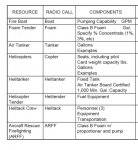I just saw this and looked at the resource list and it's nowhere near accurate in mapping NOPS rotor wing to tail numbers. Not sure what the heck they're trying to show here. Fixed wing is a mess as well. Below is what's what for this year and a few notes going back a few years
502HQ - Copter 502 KNF Scott Valley, rappel
402PJ - Copter 503 KNF Happy Camp
205BT - Copter 506 SHF
205GH - MNF Orland - T2 2020
212BT - Copter 510 LNF Chester
N20PF - Copter 512 PNF Quincy
212HP - Copter 514 TNF Grass Valley
911VR - Copter 516
811KW - Copter 517
FHQB - Copter 520
33HX - Copter 522
534HQ - Copter 527 LPF
205WW - Copter 527??
612TA - Copter 528 LPF
386HQ - Copter 530 LPF
44HX - Copter 553 BLM Ravendale
12HX - Copter 553 BLM Ravendale (2017)
6HE - Copter 553 (2018?)
262HQ - Copter 554
247AC - Helitanker 743
545DF - Nevada DF C402
987SF - Nevada DF C403
777SF - Nevada DF C405
I've not seen a list with the tail numbers since 2013.. They change from year to year due to different companies winning bids. I think the bids are for multiple year operations. In California the tail number is not used over the air like it is in the rest of the country. The Inyo's ship flew over the 4th of July parade in Mammoth Lakes and it had the wording "Helicopter 525 - Fire" shown on the bottom. I'm not sure if this is required in the contract. Now if they could require "H-xxx" on each side of the ship and this nationwide, it would be a large improvement. For a firefighter on the ground it is difficult to hear all the FAA tail numbers and relate that to the type of the ship, where it is from and what it will be doing on the fire. Air attack and other aircraft personnel can ID the ships from the air by sight, but the radio traffic is very confusing. You have to keep a list that says, for example, 45 Hotel Xray Tango is a Type 3 helo from the Humboldt-Toiyabe NF in Bridgeport in R4 and 627 Oscar Mike is a Type 2 from Prescott in Region 3. The helitanker designation using the 700 series numbers appears to be gone as well.
Your list is missing information for the following:
Note: the FAA airport designator is shown in parenthesis.
H506 - Shasta-T - Trinity Helibase (TRI)
H516 - Eldorado - Pacific Helibase (PAC)
H517 - Stanislaus - Bald Mtn. Helibase (76CA)
H520 - Sierra - Trimmer Helibase - Rappel Qualified (TRM)
H522 - Sequoia - Peppermint Helibase (PMT)
H523 - Sequoia - Kernville Helibase (L05) "Lima Zero Five"
H525 - Inyo - Independence Helibase (2O7) "Two Oscar Seven"
H527 - Los Padres - Arroyo Grande Helibase (ARG)
H528 - Los Padres - Santa Ynez Helibase (IZA)
H530 - Los Padres - Chuchupate Helibase (CHU)
H531 - Angeles - Fox Field Helibase - Night Operations (WJF)
H532 - Angeles - Fox Field Helibase (WJF)
H534 - San Bernardino - Heaps Peak Helibase (HPS)
H535 - San Bernardino - Keenwild Helibase (KEN)
H538 - Cleveland - Ramona Helibase (RMN)
H551 - Yosemite NP - Crane Flat Helibase (CFL)
H552 - Sequoia-Kings Canyon NP - Ash Mountain Helibase (2CA0) "Two Charlie Alpha Zero"
H553 - BLM Northern CA District - Ravendale Helibase (RAV)
H551 - BLM CA Desert District - Apple Valley (10CA) "One Zero Charlie Alpha"
The complete list is available in Chapter 50 (Aircraft) in the annual California Interagency Mobilization Guide. It never shows the aircraft tail numbers. The term "Helicopter" is always used not "Copter."
I'm not sure if Helicopter 531 and 532 are the same ship, with 531 being used at night and the same ship being used as 532 in the day. I think not, the night ship has additional night vision equipment and the day ship is subject to dispatches to other areas. I think the night helicopter experiment the USFS is conducting is on the Angeles NF only.





